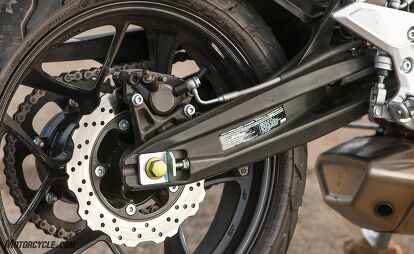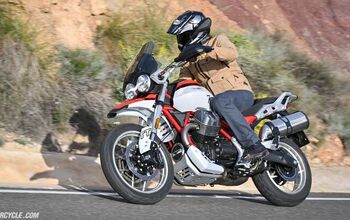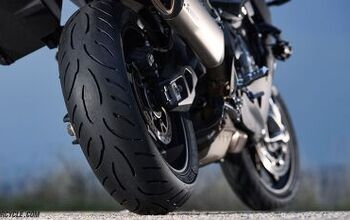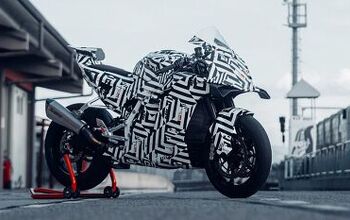2017 Hyosung GD250R Review
One big step for Hyosung, one day late for mankind
What’s up with Hyosung? The Korean bike builder just seems to do things its own way. If there’s a marketing department, it’s a secretive one that’s careful not to divulge sensitive information. When there’s a new model, it sort of just arrives… the new GD250R did make an appearance at last November’s EICMA show, but we must’ve overlooked it? Is this thing from North or South Korea? Is it a threat to national security? And what is GD acronyming anyway? Grand Douring?
2017 Hyosung GD250R
| Engine | 15.0/20 |
| Suspension/Handling | 12.5/15 |
| Transmission/Clutch | 7.0/10 |
| Brakes | 8.0/10 |
| Instruments/Controls | 3.5/5 |
| Ergonomics/Comfort | 6.0/10 |
| Appearance/Quality | 7.0/10 |
| Desirability | 7.0/10 |
| Value | 7.0/10 |
| Overall Score | 73/100 |
It’s actually a pretty striking-looking little bike; I’m picking up a whiff of early Katana up front with a delicate aftertaste of Panigale in the tailsection, maybe a bit of Aprilia Futura in the midrange. Wheels are light and airy, the cantilevered rear shock says Kawasaki; there’s Erik Buell in the under-engine boombox. It’s a big fashion-forward move from the previous GT250R, and some of the hardware looks determined to back up the sportbike claim.
We did get a brochure, and it uses all the right buzzwords: mass centralization, stressed member, steel trellis frame… judging from the specs, the GD’s liquid-cooled 249cc Single is an all-new unit, since the pre-existing GT250R is powered by a V-Twin.
The new Single is oversquare and revvable to 10,700 rpm, with a 12:1 compression ratio. The new thumper made 23.44 hp at 8900 rpm on the dyno, to the old Twin’s 25.2 at 9700 last time we sampled one. The Single produces 15.6 lb-ft of torque at 7100 to the old Twin’s 15.4 at 6500. We’re still fuel-injected, but now feeding power through a six-speed trans instead of a five-speed. The slight loss of power is accompanied by a serious loss of weight at least: The new bike registered 356 pounds, wet, on our scales (very close to Hyosung’s 352-lbs. claim); the old GT was way heavier, at 416 claimed lbs., and bigger too. The new GD is far more compact.
Unlike some others in its entry-level class, which are more “standard” motorcycles, the GD wants to be a small sportbike: Its clip-on handlebars clip on below the top clamp, its footpegs are high and tight, and its seat is not a sofa. If you’re building up to a Ducati or an R1, it’s good training. If you just want to ride a motorcycle around, those racy ergoes grow old much quicker than a bike like a Honda CBR300R.
Suspension is surprisingly good, via 37mm inverted fork and cantilevered shock at the rear. Firm but not too firm, and more compliant than many bargain-bike suspenders until the road becomes really decrepit; at that point, at least the bike’s light weight helps. On smooth pavement, the GD’s chassis is really good: That front brake (with four-piston caliper and steel braided line) feels a bit wooden around town, but seems to gain feel and power as you squeeze harder; it doesn’t overwhelm the fork when you Marquez it (nor will ABS bail you out when you give it a panic grab, since there isn’t any).
Steeper rake and trail figures and a shorter wheelbase than the old GT, along with its big weight loss, allow fearless pilots to carry most of whatever speed the bike can generate into the next corner, and the low-profile MRF REVZ radials feel up to the task. Unfortunately, I am not that fearless pilot: I brake for corners I can’t see around and gas it on the way out.
With the GD, there’s not much payoff in “gassing it.” The Single needs 7000 rpm to break the 20 horsepower barrier, and the torque curve on the way there’s a bit jagged. Above 7000 rpm and up until past 10,500, the bike feels happier, revvier and smoother – but there’s a lot of drama keeping things spinning that high, a problem that might be solvable by the simple expedient of a faster-opening throttle. On this bike, you’re at WOT about 80% of the time, so why make your wrist swivel that far to get there?
The gearbox doesn’t help: Its throws are a bit long and clunky, and it seems like it needs at least a little clutch for every shift, up or down. Which makes you wonder, what kind of oil is in there? Would a few quarts of the expensive stuff help? But then you remember the clutch is so juddery it’s hard to make a smooth launch.
You really keep wanting to like the purposeful and handsome little Hyosung, but it keeps providing reasons for you not to – subtle ones you might not care about if you hadn’t ever ridden a Honda CBR300 or a KTM 390. And really, that’s the problem: Hyosung seems to be perpetually fighting the last war. Its new GD is way better than the old GT, but the enemy has moved on. The taillight is a snazzy LED unit, but the front brake switch that activates it wasn’t plugged in on our test unit. That’s dangerous on a brand-new motorcycle.
At $4,099, the GD’s retail price is 10 to 20% less than its competitors, and it’s kind of funny that’s just about how not-as-good it is. Heck, for $200 less, if we’re not worried about playing the offbeat-manufacturer card, I like the faster, nicer Benelli TnT 300 Twin we rode a few months ago. This Hyosung is close, but still no cigar.
2017 Hyosung GD250R
+ Highs
- It actually looks pretty swell
- Engine vibes seem to go down at higher speeds
- Surprisingly pretty good suspension
– Sighs
- Little things hold it back, like the long-turn throttle
- Noise, vibration, harshness at certain rpm
- You’d think they’d wanna pull out the stops and build one really good motorcycle someday
2017 Hyosung GD250R Specifications | |
|---|---|
| Engine Type | Liquid-cooled DOHC 4-valve Single |
| Displacement | 249cc |
| Bore x Stroke | 73 x 59.6 |
| Compression Ratio | 12 : 1 |
| Max Power, claimed | 28.4 HP |
| Fuel System | Fuel injection |
| Lubrication | Wet sump |
| Clutch | Wet, Multiplate |
| Transmission | Constant mesh, Close ratio 6-speed |
| Final Drive | Chain |
| Frame Type | Steel tubular trellis perimeter main frame & Steel tubular assembly sub frame |
| Wheelbase | 52.99 in |
| Ground Clearance | 5.31 in |
| Seat Height | 31.1 in |
| Rake/ Trail | 23.5 º / 93.6mm |
| Front brake | 300mm petal-shaped spoke mounted single disc, 4-piston caliper, stainless steel hose |
| Rear brake | 230mm petal-shaped disc, 2-piston caliper, stainless steel hose |
| Front Suspension | 37mm Upside down Telescopic |
| Rear Suspension | Aluminum swingarm with gas charged hydraulic shock absorber; adjustable spring preload |
| Tires | 110/70-R17 54S / 150/60-R17 66S |
| Fuel Tank Capacity | 2.9 gal |
| Measured Wet weight, MO scales | 356 lbs |
| Warranty | 2-Year Limited – 1st year parts & labor; 2nd year parts only. |
More by John Burns











































Comments
Join the conversation
I bought one of these in New Zealand in November 2015 for $6300 NZD and did about 7000km on it before selling it. It's a nice wee bike but way too small for someone my size 189cm, 98kg. I did have a few issues with the clutch start sensor breaking twice so the bike wouldn't start and the master cylinder failed on the highway so i had no front brakes.
i can see them racing in motogp in 20 years if i last that long satu hati one heart